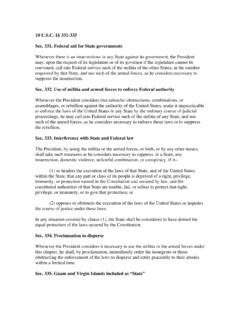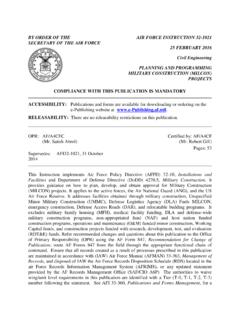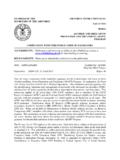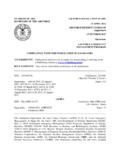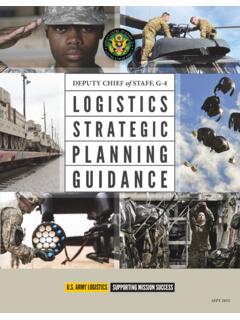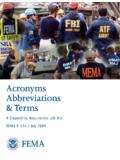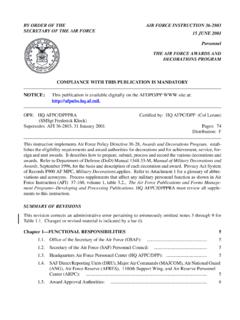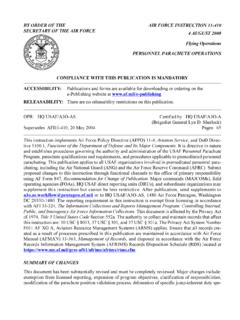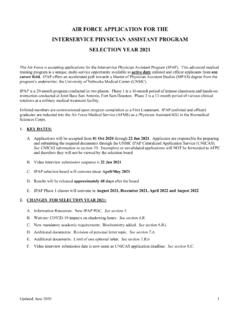Transcription of Department of Defense Mission Assurance Strategy
1 Department of Defense Mission Assurance Strategy Table of Contents The Mission Assurance : Ends, Ways, and A Strategic Framework for Mission Assurance across the DoD Pillar 1: Identify and Prioritize Critical Missions, Functions, and Supporting Pillar 2: Develop and Implement a Comprehensive and Integrated Mission Assurance Risk management Pillar 3: Use Risk-Informed Decision Making to Optimize Risk management Pillar 4: Partnering to Reduce Risk A Shared Implementing the Strategy : Next Steps..18 1 The Challenge The Department of Defense s ability to ensure the performance of its Mission -Essential Functions (MEFs) is at growing risk. Potential adversaries are seeking asymmetric means to cripple our force projection, warfighting, and sustainment capabilities by targeting critical Defense and supporting civilian capabilities and assets -- within the United States and abroad -- on which our forces depend.
2 This challenge is not limited to man-made threats; DoD must also execute its MEFs in the face of disruptions caused by naturally occurring hazards and technological failures. Many DoD Components are pioneering initiatives to address these threats to MEF performance. Yet this is generally done in an uncoordinated fashion that can result in duplicative programs and leave crucial risks unmitigated. DoD requires a comprehensive and integrative framework to assess and address risks to MEFs. This framework should also help DoD prioritize investments to ensure MEF performance in a constrained fiscal environment. This document outlines DoD s Strategy for Mission Assurance . The Strategy defines Mission Assurance as: A process to protect or ensure the continued function and resilience of capabilities and assets - including personnel, equipment, facilities, networks, information and information systems, infrastructure, and supply chains - critical to the performance of DoD MEFs in any operating environment or Assurance focuses on the protection, continued function, and resilience of capabilities and assets critical to supporting MEFs, rather than the operational execution of DoD missions themselves.
3 Within the context of Mission Assurance , readiness is based on the Joint Mission Essential Task framework and is assessed and tracked in the Defense Readiness Reporting System. Finally, Mission Assurance is a common integrative framework - - not a single policy or program -- to prioritize protection and resilience efforts and reduce risks from a range of complex threats and hazards. Mission Assurance will leverage existing protection and resilience programs, including but not limited to, antiterrorism, physical security, Defense critical infrastructure, and information Assurance . It will also provide input to existing DoD planning, budgeting, requirement, and 1 The Mission Assurance definition in this Strategy supersedes the definition in the DoD 2005 Homeland Defense and Civil Support Strategy and will be incorporated into a revised DoD Directive This definition does not supplant the Mission Assurance concepts and definitions in place within the quality control, acquisition, and systems engineering communities.
4 2 acquisition processes. The effectiveness of Mission Assurance will be measured in relation to DoD s ability to continue to perform its Strategy merges the benefits of a consistent strategic DoD-wide risk management framework with the advantages of case-specific implementation at various levels across DoD. For example, the heads of DoD Components need to base their protection and resilience decisions on a common framework. Otherwise, it will remain difficult for senior leaders to make use of data resulting from conflicting Component assessments and prioritize risk reduction efforts across DoD. At the same time, Component heads and installation commanders have the best understanding of local, site-specific circumstances that affect risk management . The Strategy will leverage this local expertise, and keep Component and installation commanders at the leading edge of Mission Assurance .
5 This comprehensive Mission Assurance framework will also provide increased visibility of systemic risks and trends affecting MEFs across individual Components and installations. This will allow DoD to identify and address strategic risk issues more appropriately, particularly those involving external dependencies outside DoD Component control that may jeopardize DoD Mission execution, both domestically and internationally. For example, DoD and industry partners are pursuing strategic solutions to DoD s overall dependence on commercial electric power rather than exclusively relying on back-up generators at the installation level. The framework outlined in this Strategy aligns with the risk management framework and strategic objectives described in the Quadrennial Defense Review (QDR) and other DoD strategic guidance and planning documents.
6 This Strategy identifies the principal pillars and initial actions needed to implement the Mission Assurance framework throughout DoD. Threats to DoD Mission Performance The attacks of September 11, 2011, represented a striking example of the challenge that confronts us today. On September 11, Al-Qaeda asymmetrically employed elements of critical infrastructure systems, in a manner that our military was not ready to counter, to strike the World Trade Center and the Pentagon. This type of asymmetric threat has been growing in many ways ever since. Today, potential adversaries seek both lethal and non-lethal means to attack, or otherwise disrupt, DoD and civilian assets. 2 Performance measurement requires recognition that a positive Mission impact may not be demonstrated by a quantifiable event or action, but may in fact be shown by the absence of an unwanted event.
7 3 Both this Mission Assurance Strategy and the Defense Strategy for Operating in Cyberspace (DSOC) address information Assurance must address an all-threat and all-hazards environment, DoD and non-DoD risks, and cascading downstream effects on MEFs: They differ, however, in depth and scope. The DSOC establishes new policy to guide DoD cyberspace operations and outlines strategic initiatives to achieve cyberspace operational objectives. The Mission Assurance Strategy has a broader focus and leverages, rather than replicates, the in-depth guidance provided by DoD s cyber Strategy . The Mission Assurance Strategy provides a framework for risk management across all protection and resilience programs. The Mission Assurance Strategy also accounts for the full range of threats and hazards to the capabilities and supporting assets on which our fighting forces depend, not just cyber threats.
8 1. Threats and hazards to Mission execution range from naturally occurring events to unintentional or deliberate manmade disruptions. This includes incidents such as earthquakes, naturally occurring pandemics, space weather events, technological failures, and industrial accidents, as well as physical or virtual attacks by state or non-state actors. Threats can also emanate from insiders with ties to foreign counterintelligence organizations, homegrown terrorists, or from individuals who have a malicious agenda, as evidenced by the 2010 Wikileaks incident or Fort Hood shootings. This Strategy rests upon an all-threats, all-hazards framework for risk assessment and remediation and assumes that simultaneous or coordinated attacks or Mission disruptions are very possible ( , a hybrid cyber and physical attack or disruption).
9 2. Threats to non-DoD government and commercially owned infrastructure, facilities, and capabilities - including the Defense Industrial Base (DIB) - can jeopardize DoD Mission execution. A Mission Assurance Strategy focused only on DoD-specific vulnerabilities is likely to fail. DoD must adopt a comprehensive framework for Mission Assurance in order to manage risk in a way that accounts for DoD dependence on civilian capabilities and assets, the second and third order cascading consequences of their disruption, and the physical risk posed by the proximity of certain civilian critical infrastructure facilities to Defense 3 DoD released its Defense Strategy for Operating in Cyberspace in July 2011. The Strategy describes five Strategic Initiatives: treat cyberspace as an operational domain to organize, train, and equip so that DoD can take full advantage of cyberspace s potential; employ new Defense operating concepts to protect DoD networks and systems; partner with other Federal departments and agencies and the private sector to enable a whole-of-government cybersecurity str ategy; build robust relationships with Allies and international partners to strengthen collective cybersecurity; and leverage the nation s ingenuity through an exceptional cyber workforce and rapid technological innovation.
10 This framework must also recognize the lead role of other Federal 4 These supporting capabilities, assets and infrastructures include, but are not limited to, transportation networks; global supply chains; electric power, telecommunications, and information technology systems; nuclear power plants; chemical manufacturing facilities; dams; and water treatment plants. 4 departments and agencies (especially the Departments of Homeland Security, Energy, and Transportation), commercial infrastructure owners and operators, and other private sector and international partners in coordinating risk mitigation strategies for threats to private sector and Federal non-DoD infrastructure. 3. Many attacks or disruptions could not only degrade or disrupt DoD s net-dependent operations, but may also have downstream physical effects that would further affect the performance of MEFs.
